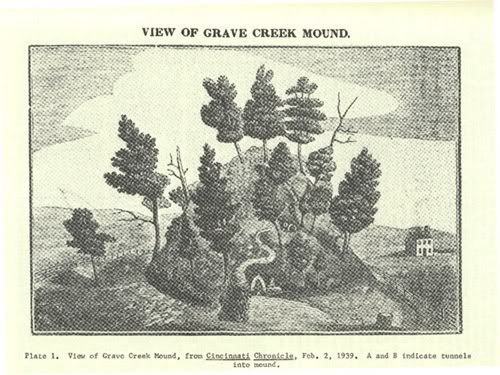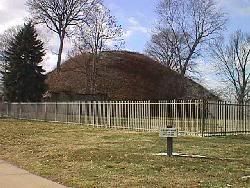Grave Creek Mound

The largest and one of the most famous Adena burial mounds, Grave Creek Mound is located in, the appropriately named, Moundsville, West Virginia. The mound is 62 feet high and 240 feet in diameter and is over 2000 years old. Evidence shows that the mound was built in successive stages from about 250-150 B.C.. Originally a moat with a width of 40 feet and a depth of 5 feet encircled the mound. It is said to have been discovered by Constantine O'Neal in 1770, a full 33 years before Lewis and Clark wrote of it in their journals during their expedition after the Louisiana Purchase.
"About 1000 B.C. marks the beginning of a new period in North America. Called the Woodland Period, this period lasted until about 700 A.D. During this time, a new culture emerged and made signigicant settlements in what is now known as West Virginia. These people are known to us today by the general term the Mound Builders, so called for their practice of creating earthen burial mounds and other earthworks. The Mound Builders lived over a wide range from the Atlantic, the Midwest and the Ohio Valley to the Mississippi Valley. The term "mound builders" refers to several cultures that span a period of about 20 centuries. " (from http://www.wvculture.org/sites/gravecreek.html)
The Adena people lived from about 1000 BC to about 1 AD, and were the first group of people to adapt this way of life. They lived in eastern United States in Ohio, Indiana, West Virginia, Kentucky, and parts of Pennsylvania and New York.
The mounds were usually built as part of a burial ritual. Most of the people were cremated, but more important people were buried in the flesh along with various artifacts such as beads, pipes and copper ornaments.
The building of the mound must have been a huge task as over 60,000 tons of earth had to be moved, ans the Adena people did not use the wheel and had no horses. The dirt has to be carried out by the basket full, an enormous task as you can imagine. Once there were thousands of these mounds found in the United States. But today, only a few still exist. The Grave Creek Mound is the largest of the remaining Adena mounds.
Lewis and Clark wrote this is of the Grave Creek Mound in their journals:
September 10, 1803
"The rain ceased about day, the clouds had not dispersed, and looked very much like giving us a repetition of the last evening's frallic, there was but little fogg and I should have been able to have set out at sunrise, but the Corporal had not yet returned with the bread—
I began to fear that he was
This remarkable mound of earth stands on the east bank of the Ohio 12 miles below Wheeling and about 700 paces from the river, as the land is not cleard the mound is not visible from the river—
this mound gives name to two small creeks called little and big grave creek which passing about a half a mile on each side of it & fall into ohio about a mile distant from each other
the small creek is above, the mound stands on the most elivated ground of a large bottom containing about 4000 acres of land the bottom is bounded from N. E. to S. W. by a high range of hills which seem to discribe a simecircle around it of which the river is the dimater, the hills being more distant from the mound than the river, near the mound to the N. stands a small town lately laid out called Elizabeth-town there are but about six or seven dwelling houses in it as yet, in this town there are several mounds of the same kind of the large one but not near as large, in various parts of this bottom the traces of old intrenchments are to be seen tho' they are so imperfect that they cannot be traced in such manner as to make any complete figure; for this enquire I had not leasure. I shall therefore content myself by giving a discription of the large mound and offering some conjectures with regard to the probable purposes for which they were intended by their founders; who ever they may have been.—
the mound is nearly a regular cone 310 yards in circumpherence at it's base & 65 feet high terminating in a blont point whose diameter is 30 feet, this point is concave being depressed about five feet in the center, arround the base runs a ditch 60 feet in width which is broken or intesected by a ledge of earth raised as high as the outer bank of the ditch on the N. W. side, this bank is about 30 feet wide and appers to have formed the enterence to fortifyed mound—
near the summet of this mound grows a white oak tree whose girth is 13 ½ feet, from the aged appeance of this tree I think it's age might resonably calculated at 300 years, the whole mound is covered with large timber, sugar tree, hickory, poplar, red and white oak &c—
I was informed that in removing the earth of a part of one of those lesser mounds that stands in the town the skeletons of two men were found and some brass beads were found among the earth near these bones, my informant told me the beads were sent to Mr. Peals museum in Philadelphia where he believed they now were.— "
(from http://lewisandclarkjournals.unl.edu/hilight.php?id=11&keyword=september+10,+1803&keyword2=&keyword3=)

Grave Creek Mound




0 Comments:
Post a Comment
Subscribe to Post Comments [Atom]
<< Home